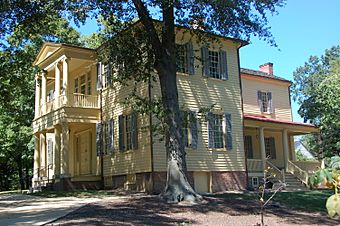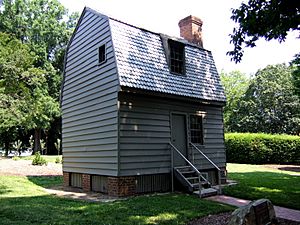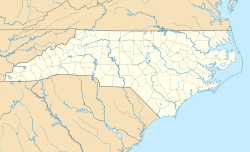Mordecai House facts for kids
Quick facts for kids |
|
|
Mordecai House
|
|
|
U.S. Historic district
Contributing property |
|
 |
|
| Location | Mimosa St., Raleigh, North Carolina |
|---|---|
| Area | 3.9 acres (1.6 ha) |
| Built by | Joel Lane |
| Architect | William Nichols (1824 renovation) |
| Architectural style | Hall and Parlor/Federal/Greek Revival |
| NRHP reference No. | 70000474 |
| Added to NRHP | July 1, 1970 |
The Mordecai House is a historic home and museum in Raleigh, North Carolina. Built in 1785, it is the oldest house in Raleigh that still stands on its original spot. Today, it is the main attraction of Mordecai Historic Park.
This park is next to the Historic Oakwood neighborhood. Besides the Mordecai House, the park also has other important buildings. These include the birthplace of U.S. President Andrew Johnson, the Ellen Mordecai Garden, and St. Mark's Chapel. Many people use the chapel for weddings.

Contents
History of the Mordecai House
Early Beginnings
The first part of the Mordecai House was built by Joel Lane for his son, Henry. Joel Lane is known as a founder of Raleigh. He sold 1,000 acres of his land to create the city.
At one time, the Mordecai property was a very large plantation. It covered about 5,000-acre (20 km2) of land. This made it one of the biggest plantations in Wake County.
The Mordecai Family
The house was named after Moses Mordecai. He inherited the house through his first wife, Margaret Lane. After Margaret passed away, Moses married her sister, Ann Lane.
In 1824, Moses Mordecai hired William Nichols. Nichols was the State Architect at that time. He helped make the house much bigger. In 1826, four new rooms were added. This changed the house into a grand Greek Revival mansion.
The Mordecai family was one of the first Jewish families in the United States. They were important people in their community and in North Carolina. Moses Mordecai was a well-known lawyer. His father, Jacob Mordecai, started a school for girls.
Moses and his first wife, Margaret, had two sons, Henry and Jacob, and a daughter, Ellen. With his second wife, Ann, he had another daughter named Margaret. Henry Mordecai became a successful farmer at Mordecai House. He was also elected to the State Legislature. Many people worked on the plantation, including fourteen enslaved individuals who lived and worked there.
Henry's daughter, Margaret Mordecai, later inherited the mansion. Her family members continued to live in the Mordecai House until 1967.
Land Sales and Preservation
Over the years, the Mordecai family sold off parts of their land. This land was used to help Raleigh grow. In 1867, George Washington Mordecai, a family member, gave land to create a cemetery for Confederate soldiers. He also donated land for Wake County's first Hebrew Cemetery.
The nearby Oakwood Cemetery was started in 1869. The area around it, once known as Mordecai Grove, became the large Oakwood neighborhood. In 1974, Oakwood was the first neighborhood in Raleigh to be listed on the National Register of Historic Places.
In 1967, the Mordecai House and its surrounding land were put up for sale. People who cared about history wanted to save it. The city of Raleigh bought the property. They gave it to the Raleigh Historic Sites Commission to turn it into a historic park. The commission found many of the original Mordecai family items and papers.
Today, the City of Raleigh's Parks, Recreation and Cultural Resources Department manages Mordecai Historic Park. The Mordecai House is a special Raleigh Historic Landmark.
Haunted History and Folklore
The Mordecai House is known for its spooky stories. Many people believe it is the most haunted house in Raleigh. It was even shown on the TV show Ghost Hunters. The TAPS team investigated some of the claims about ghosts there.
From 2008 to 2016, a group called NSPIR was the only team allowed to research paranormal activity at the park. Since 2017, The Ghost Guild Inc. has been the official paranormal research team. They visit the house and other buildings at least three times a year. They share what they find at the park's yearly festival in October.
Visitors and workers have reported seeing a woman in old-fashioned clothes. She wears a long black skirt, a white shirt, and a black tie. People say she moves quietly through the hallways. Some even say they have seen her standing on the balcony late at night. In recent years, visitors have also heard a piano playing by itself.
See also
- List of Registered Historic Places in North Carolina
- List of reportedly haunted places in North Carolina
- List of the oldest buildings in North Carolina
- List of residences of presidents of the United States



